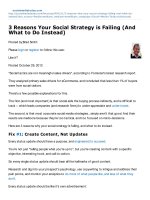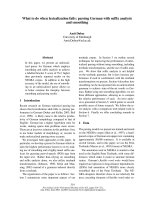What to Do with Failing Students
Bạn đang xem bản rút gọn của tài liệu. Xem và tải ngay bản đầy đủ của tài liệu tại đây (60.23 KB, 2 trang )
What to Do with Failing Students
by Marty Dawley
Why does failure bother teachers so much? When the student fails, we feel we have failed.
Over the years I have found that one of the biggest problems my colleagues have is the
feeling of personal failure that comes when their teaching doesn't work, when they teach,
but some students just won't learn. I always encourage them not to ignore the problem, but
instead to make it their responsibility to try to help those failing students find a way to
succeed. Success does not always mean passing a class or even learning the material.
Sometimes it means students must learn other lessons about themselves and how to work in
school and the world. Sometimes the results of your work still seem negligible or even
negative, but trying to help is our solemn responsibility. Looking at the whole student and
trying to help him learn how to accomplish his goals or choose other goals is a major part
of our jobs. What is failure? Failure is when a student doesn't leave the class knowing more
than when he entered. There are many types of failing students. They all deserve our help.
Helping Students to Succeed: A Twelve Step Program
1. Identify failure early and act on it. This includes getting evidence of students level
and abilities within the first week of class through testing, in class writing, and
interviews.
2. Confront the student privately with facts (test papers, lack of study and homework,
class requirements including time, etc.). Many students are anxious to deny there is
a problem. "Don't worry, teacher. No problem." Be specific and blunt. " There is
not a single correct sentence in this composition." Also use your good judgment.
Some students need this more than others.
3. Get the student to verbalize her own problem and identify causes and solutions.
Don't allow the student to minimize the problem. Analyze the problem with the
student. This self recognition is the key to any self help program. The student must
recognize the problem and decide she wants to fix it.
4. Listen. Be honest and direct in your responses. Offer respect and encouragement.
Listen and look with great attention. Look at the distance a student holds the book
from him as he reads. Listen to what she says about her study time. Let the time
you spend with this student be exploratory. You may have only seen symptoms of
the problem, but not have any idea of its source.
5. Help the student create a plan of action with realistic goals. Help her to move back
to a reasonable starting place. Help her develop steps to reaching her goal. Don't
guarantee her a passing grade. Offer her a chance to make progress.
6. Make sure the student adopts the plan as his own set of goals and responsibilities.
Let him write or articulate his plans. Check carefully to see if you are on the same
track. Make sure he includes his own ideas.
7. Follow up on the plan daily or each time you meet. Let the student know you are
interested in her success. Congratulate her on daily successes in front of others if
it's appropriate. "Your grammar was much better in this paper." "This is your
highest grade this term." Your reinforcements can become less regular as the
student improves.
8. Remind the student of his goals. Be positive, but firm. Don't reinforce the student's
bad reputation. Don't make negative comments in front of the class, but do ask him
to come and see you. He may need help. Watch for backsliding. Old habits are hard
to break.
9. Be a resource. Offer or locate additional instruction and materials at an appropriate
level. Keep files to help you come up with materials easily. Peer tutors are another
valuable tool. Know what other classes and community resources are available to
help a student in need.
10. Vary your approach to help keep students interested and to accommodate varied
learning styles, and intelligences. Give your failing student a chance to shine. Don't
lower your standards to accommodate a student who is "working hard." Your whole
class will benefit from this step.
11. Acknowledge growth even when it does not include passing a test or class. Make
sure you spend time with that student before she receives an F on a major paper, a
test, or the class. A minute before class begins is all it takes to say, "Those passive
verbs are still really hard for you, but I could see you worked on them. Let's try
again." Once again, let the student verbalize his own growth. "Do you read better
now than you did nine weeks ago?" "Yes, I do. I know more words, and I read
better." Don't give a student a passing grade for trying hard. It only takes her to a
harder, more impossible level.
12. Keep a professional outlook. If you have followed this plan, you have done your
best. The student is responsible for his successes and failures.









